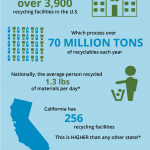After landfilling, recycling is the most common method of waste management in the United States with 21% of municipal solid waste (MSW) processed at recycling facilities and 64% sent to landfills.* Across the U.S., cities and states are setting recycling goals to increase the recovery and beneficial reuse of materials.
This America Recycles Day, learn more about these goals and U.S. recycling operations.
How are recyclables defined?
While recyclables may be defined specifically as commodity recyclables (i.e. paper, plastic, metal, glass) or include activities like composting or energy recovery from waste, an upcoming report from EREF has found at least 18 different ways states are defining and reporting recycling. This variability in definition makes it difficult to quantify actual diversion rates, as there is no set standard.
Why are U.S. cities and states setting recycling goals and policies?
The most commonly cited reasons are to increase energy conservation, protect environmental quality, improve public health and better manage our resources.
How many states have recycling or diversion goals in place?
Currently, 45 states (90%) have set recycling or diversion rate goals, which range from encouraging specific, stated activities (e.g. recycling, composting) to focusing on reducing total waste being managed each year. Twenty-three of these goals are written as recycling goals.
What are the targeted recycling rates?
States’ target recycling rates range from 10% – 80% with some citing a deadline to reach the goal while others are open-ended.
Where do recyclable items go after discard?
The sorting and processing of commodity recyclables happens through a network of over 3,900 recycling facilities made up of Materials Recovery Facilities (MRFs) and non-MRFs (i.e. smaller, low-technology facilities).
What are Materials Recovery Facilities (MRFs)?
MRFs accept, sort and process recyclable material for re-use. These facilities are classified either as clean, where recyclables are already pulled from the waste before arrival at the facility, or mixed-waste, where recyclables and waste materials are collected together, then separated from the waste through manual and/or automated sorting upon arrival.
How much waste is processed through a recycling facility?
Each year, over 70 million tons of recyclables are processed. A large MRF could manage up to 200,000 tons/year.
Looking for more recycling data?
Additional recycling data can be found in EREF’s Data & Policy (D&P) reports here. Look for EREF’s report on recycling policy this winter!
Data is collected, aggregated and analyzed through the foundation’s Data & Policy Program. D&P projects serve as a resource for solid waste-related data for researchers and decision-makers within other areas such as sustainability and environmental policy. Fees charged for D&P reports are used to provide internships to college students who assist in data gathering and analysis efforts for the program.
*Found in EREF’s report “Municipal Solid Waste Management in the U.S.: 2010 & 2013.”





